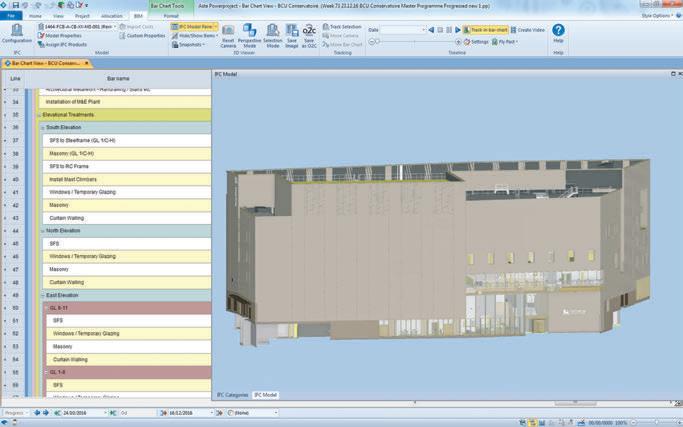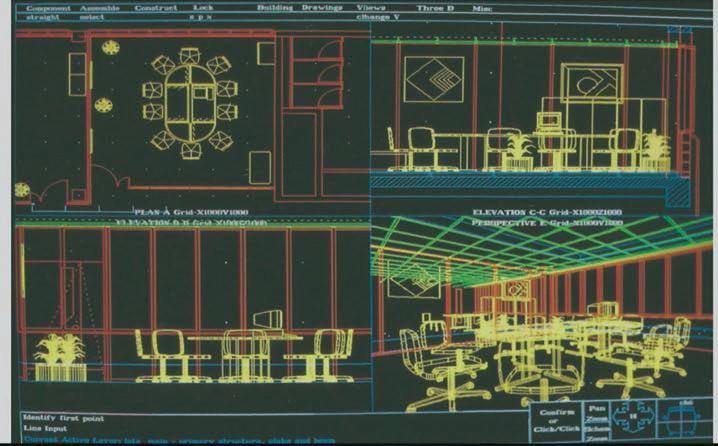
9 minute read
Bravo, maestro
At the Birmingham Conservatoire, Galliford Try is using Asta Powerproject BIM as its platform for 4D planning in order to orchestrate a polished performance.
In a £57 million project for The company is a regular user of Asta exactly where the project should be and Birmingham City University, con- Powerproject as a planning software plat- where it is. Without the video you’d spend struction company Galliford Try is form and adopted the BIM version to lot of time trying to explain where we are creating the UK’s first new conserv- deliver that integrated perspective. When and where we should be. With the video, atoire since the mid-1980s. the project started, graduate Ibrahim Patel they can see it straight away.”
The Birmingham Conservatoire has had recently joined the group as a planner, Subcontractor communication was been designed around multiple perfor- with the new Birmingham Conservatoire also a beneficiary, as Patel outlines: “We mance spaces, to include a 500-seat main as his first project. He was given the task have progress meetings with individual concert hall, a 150-seat recital hall and of creating a 4D plan that would give the subcontractors where we pull up the three other venues, as well as teaching project team an integrated view of activi- Asta Powerproject programme and go facilities. ties and progress of the building in the through their works. As well as discuss-
The project began in August 2015 and form of a 3D visualisation. It provided a ing how far they have come along and is scheduled to compete this coming hub into which all the as-built informa- anything they are putting in place to get August, so that the Conservatoire can tion marked up on working drawings and back on track, we can also look ahead. open for the new 2017/18 academic year documents could be integrated, to main- We can re-sequence works to save us in September. tain a current view of progress. time in the future or avoid several con-
It was designed as a BIM project from “The 4D BIM model we created in Asta tractors working in the same space at the outset. Having always been a believer Powerproject BIM gave us a visualisation the same time,” he says. in quality standards, Galliford The software was used to link Try was among the first wave of contractors to secure its full BIM accreditation. ‘‘ The 4D model we created in Asta as-built information to the visualisation, he continues: “Asta Powerproject BIM gives us a The project’s main technical challenges centre on the client’s Powerproject BIM gave us a high-level overview of the project. As we get into the nittyoverarching acoustic require- visualisation model alongside our gritty of activities, we capture ments. The building has been designed using a ‘box in box’ main BIM model information within our as-built documents. For example, for an construction approach, incorporating five independent steel ’’ elevation of brickwork, we have a drawing that is marked up to frames for each main space, isolated model alongside our main BIM model,” show the brickwork that has gone up from the main building structures via he explains. each week, which goes into the as-built resilient, individual, anti-vibration We always have lots of as-built records document stack. We can take that inforacoustic mountings, which effectively and drawings on paper. We could now mation and put it into Asta Powerproject create completely floating floors. This take that information, put it into the 4D BIM, and the model then gives us a visual aspect required the involvement of spe- BIM model, and gain a 3D representation overview of what has happened too. cialist subcontractors and innovative of that information to see it more clearly. construction and working processes. It instantly becomes easier to see both Driving a digital future what is planned, and what has happened, Digital construction technologies are 4D BIM delivers extra perspective in one place. new to some in the construction sector. The project’s BIM model was designed by The visualisation provided an integrat- However, Patel was more than confident the architect in Autodesk Revit, into ed view of progress for the planners, and about adopting the new software, having which was incorporated numerous sub- was made accessible via Microsoft recently completed his degree in contractor programmes. Although it SharePoint to senior management, if they Architectural Design Technology at would be up dated regularly, and a com- required it. However, it became most val- Coventry University. He is one of several prehensive as-built documentation stack uable when used as the basis for client new entrants bringing in critical digital would be compiled by the site team, communication, says Patel. skills at Galliford Try, and performing Galliford Try decided that creating close “The visualisation you create in Asta important roles as champions of a digiintegration between the model and pro- Powerproject BIM really benefits the client. tal future. gramme activities would be critical to When they come in for their monthly meet- “As a graduate, your eyes have already maintaining control, managing progress, ing, we can easily produce a video to show been opened during your studies as to and assuring excellent communications the planned model versus an actual model. what technology can do in construction, during the project. That shows them within just a few minutes and how it can move things forward. From
my relatively limited experience, I can already see that digital technologies could help transform the speed of information in construction, as well as benefit health and safety and other things. Quite a few graduates are employed at the group, and we are all trying to implement the technologies available. It helps colleagues who are less familiar with technology to see the benefits that are possible.”
That is something that is becoming even clearer as the company also does such things as roll out iPads for on-site use, enabling the company to digitise all the many operational forms required to run the site, perform inspections and write reports.
Patel’s 4D planning work has been such a success that Galliford Try is now working to extend the benefits to another major contract, also in the West Midlands, as it utilises BIM to manage a £40 million contract to deliver a major private rental sector project. This involves delivering 323 apartments, over two high-rise blocks, in the heart of Birmingham.
“[Birmingham Conservatoire] is the first project where we have used 4D planning with Asta Powerproject BIM, so it’s been a big learning curve – but it has not only delivered benefits, but also is a good foundation for potentially stepping into 5D planning later.
“This project was a starting point. Now we’ve seen what it can do, we can roll it out to further projects. Another graduate planner is starting on the next Birmingham project, and I am assisting him where possible in implementing 4D planning.”
■ elecosoft.com
1 The North West elevation of the new Birmingham Conservatoire, home to five performance venues 2 Asta Powerproject BIM is used to link as-built information to a visualisation that provides an integrated view of progress 3 As work continues, it becomes easier to share with subcontractors where the project is and what needs to happen next


Celebrating the history of BIM
At DEVELOP3D LIVE in March Dr Jonathan Ingram gave a fascinating talk on his work in the development of early CAD systems which were the forerunners to the BIM systems of today
At this year’s excellent BIM Show Live event in Newcastle, AEC Magazine bumped into someone we hadn’t seen for about 20 years – Dr Jonathan Ingram, the creator of the first BIM tools (Sonata and Reflex (and Pro Reflex), had come to his first BIM event in roughly the same length of time.
Dr Ingram is writing a book on modelling development and usage from the early 3D systems and gave a fascinating talk on the evolution and application of intelligent 3D systems for the built environment in the 70s, 80s, 90s and 2000s.
We were so taken by this talk that we asked him to speak at DEVELOP3D LIVE, a conference organised by our sister publication He agreed and now his presentation is available to view online at tinyurl.com/BIM-ingram
Intelligent AEC modelling really started with BDS – the Building Design System. While this was a 2D system, it featured multi-representational objects, where each ‘object’ would display a different graphic if it were in plan, section or elevation.
From this experience in the early 80s, Dr Ingram set about to create a true 3D modelling environment, which culminated in T squared’s Sonata application which ran on Apollo workstations and is now recognised as being the first true BIM system. Despite the incredible cost of both hardware and software (over £100,000), many global practices took on seats and it really started to change the way large practices thought about modelling and Computer Aided Design. Sonata was eventually sold to Alias.
Dr Ingram’s next application was called Reflex and took the concepts defined in Sonata and delivered them on the then new range of Silicon Graphics IRIX Workstations, the Pro Reflex running on desktop PCs. Eventually this was sold to mechanical CAD specialist PTC, which failed to enter the AEC market. Two of PTC’s programmers, Leonid Raiz and Dr. Irwin Jungreis left the company and took with them a development licence of Pro Reflex. Pro Reflex plus others eventually inspired them to developed Revit, which was eventually sold to Autodesk. Global domination ensued.
In the summer of 2016, Dr Jonathan Ingram was awarded the Royal Academy of Engineering Prince Philip Medal for his work developing systems which led to BIM, by HRH The Duke of Kent at the Royal Academy of Engineering’s Awards Dinner. The award is given out biannually to those who have given exceptional contributions to engineering through practice, management or education.

DEVELOP3D Live
AEC Magazine has a sister publication, DEVELOP3D
(develop3d.com), which runs a
conference and exhibition for the very latest in product design, engineering and manufacturing technology.
Many AEC Magazine readers attend DEVELOP3D Live, as it covers the cutting edge of design visualisation, VR/AR and digital fabrication. It offers the AEC industry a chance to learn from the manufacturing sector, which has historically been more advanced and faster to adopt new technology.
At DEVELOP3D Live 2017 in March, there were 43 presentations, which can all be viewed online at develop3dlive.com.
DEVELOP3D Live 2018 will be held in Warwick on 20 March next year. Meanwhile, to see the latest developments in AEC technology, attend NXT BLD (nxtbld.com) on 28 June.











